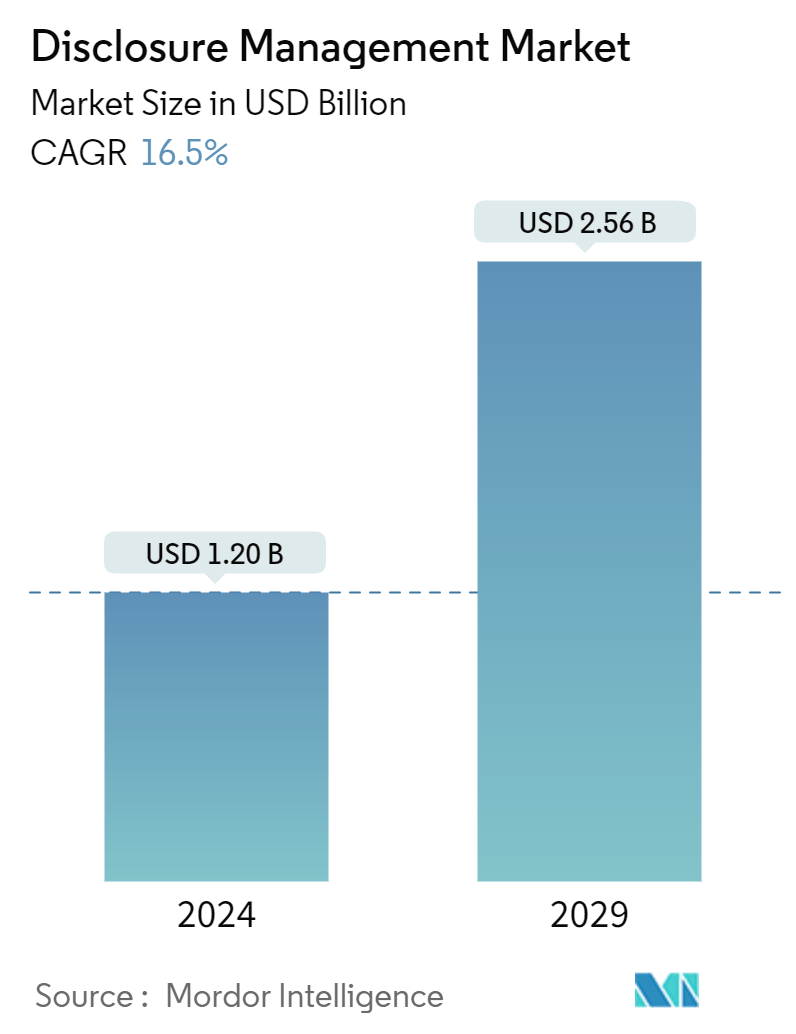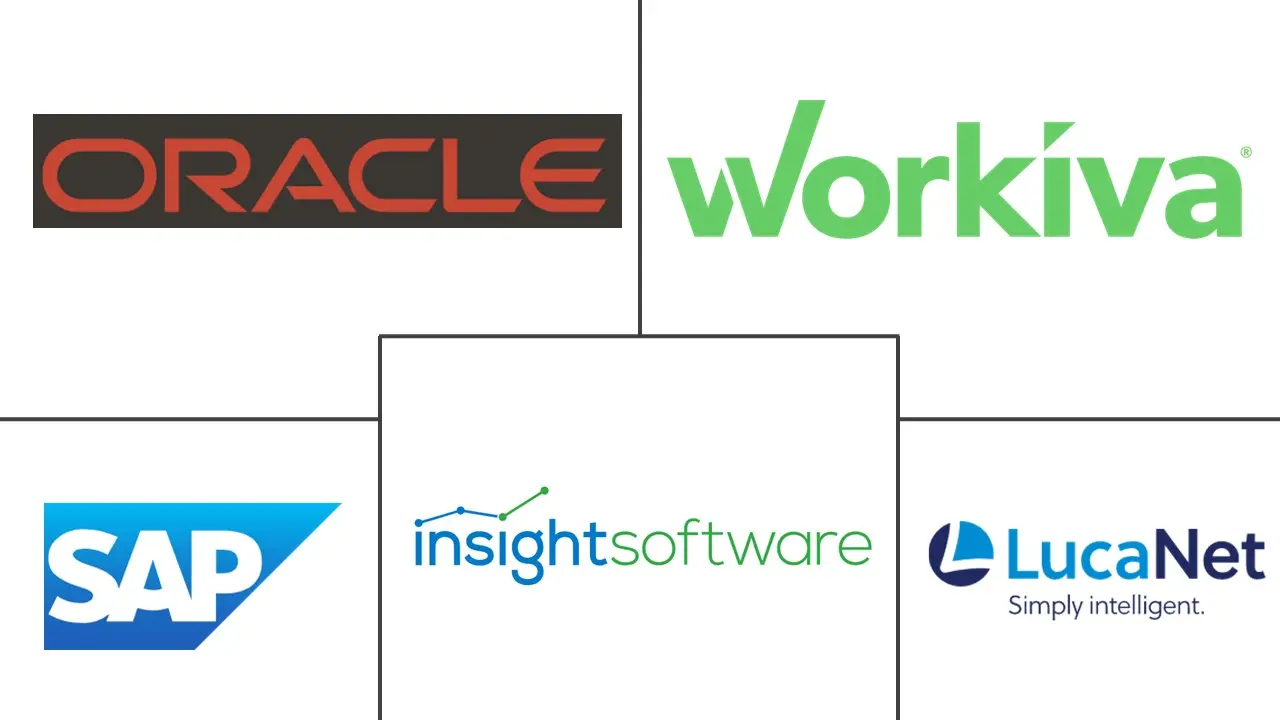Market Size of Disclosure Management Industry

| Study Period | 2019 - 2029 |
| Market Size (2024) | USD 1.20 Billion |
| Market Size (2029) | USD 2.56 Billion |
| CAGR (2024 - 2029) | 16.50 % |
| Fastest Growing Market | Asia Pacific |
| Largest Market | North America |
Major Players
*Disclaimer: Major Players sorted in no particular order |
Disclosure Management Market Analysis
The Disclosure Management Market size is estimated at USD 1.20 billion in 2024, and is expected to reach USD 2.56 billion by 2029, growing at a CAGR of 16.5% during the forecast period (2024-2029).
- Disclosure management in reporting assists organizations in creating and editing visually labeled extensible business reporting language (XBRL) filings to a regulatory body, such as a 10K or 10Q filed to the SEC or comparable government agencies. Financial statements, comments, and supporting schedules can be compiled in Microsoft Excel or Word and then mapped and delivered in PDF, XBRL, HTML, or EDGAR formats.
- The evolution of digital technologies has revolutionized the way financial disclosures are managed. The rise in artificial intelligence and automation usage is one of the key trends in this space. Automation enables streamlining processes, reducing errors, and improving disclosure management accuracy. Artificial intelligence-driven solutions can automate document review, data extraction, and analysis tasks. This authorizes faster processing times and improved precision when dealing with large volumes of data. Data management and security have also become increasingly essential considerations regarding financial disclosure management.
- Several multinational companies, including Comcast, Coca-Cola, Pfizer, and Procter & Gamble, have implemented AI-led automation tools to improve their financial reporting processes. By using machine learning algorithms, cloud-based platforms, and visualization software, these companies have reduced the time taken for financial reporting, improved the accuracy of their financial data, complied with regulations, and made more informed decisions based on their financial data.
- The improved focus on regulatory requirements and standards has led to more stringent enforcement actions against those firms that fail to adhere to them, resulting in higher fines and fines imposed upon violators. Furthermore, the shift toward more significant transparency has been further accelerated by the evolution of blockchain-based solutions, which allow secure real-time sharing of confidential data between parties without requiring third-party intermediaries, thus decreasing costs and complexity associated with conventional methods.
- There is a rising focus on sustainability reporting, which mandates companies to disclose environmental effects along with conventional financial performance metrics such as income growth or profit margins to better notify stakeholders about their overall implementation across multiple dimensions rather than just focusing solely on short-term gains at the expense of long-term viability. These are expected to drive the demand in the disclosure management market.
- However, constraints related to regulatory disclosure processes are expected to challenge the growth of the market. With the recent uptick in the adoption of the cloud among different end users, the impact of the COVID-19 pandemic has further accelerated the offerings of DAM systems. For instance, according to a survey by MariaDB, 40% of global respondents accelerated their move to the cloud, and 51% planned to drive more applications to the cloud to prepare for future COVID-19 shutdowns. Such trends increased the demand for cloud-based disclosure management solutions in the market.
Disclosure Management Industry Segmentation
Disclosure management involves the identification, collection, preparation, and distribution of information to stakeholders in a timely and accurate manner. The report tracks the key market parameters, underlying growth influencers, and major vendors operating in the market, supporting market estimations and growth rates over the forecast period.
The scope of the study includes segmentation of the market by component (software and services), deployment type (on-premises and cloud), end-user industry (BFSI, IT and telecom, healthcare, retail, manufacturing, and other end-user industries), and geography (North America, Europe, Asia-Pacific, Latin America, and the Middle East and Africa). The market sizes and forecasts are provided in terms of value (USD) for all the above segments.
| By Component | |
| Software | |
| Services |
| By Deployment | |
| On-premises | |
| Cloud |
| By End-user Industry | |
| BFSI | |
| IT and Telecom | |
| Healthcare | |
| Retail | |
| Manufacturing | |
| Other End-user Industries |
| By Geography | |
| North America | |
| Europe | |
| Asia-Pacific | |
| Middle East and Africa | |
| Latin America |
Disclosure Management Market Size Summary
The disclosure management market is poised for significant growth, driven by the increasing complexity of financial reporting and the need for compliance with stringent regulatory standards. The market is experiencing a transformation due to advancements in digital technologies, particularly the integration of artificial intelligence and automation. These technologies are streamlining disclosure processes, enhancing accuracy, and reducing the time required for financial reporting. Companies are increasingly adopting cloud-based solutions to manage disclosures more efficiently, a trend accelerated by the COVID-19 pandemic. The focus on sustainability reporting is also gaining traction, as organizations are required to disclose environmental impacts alongside traditional financial metrics, further propelling market demand.
The banking, financial services, and insurance (BFSI) sector is expected to dominate the disclosure management market, driven by the need for robust risk management and compliance solutions. The Asia-Pacific region, with its rapidly evolving BFSI industry, is witnessing significant growth due to digitalization efforts in countries like India and China. North America is also experiencing substantial market expansion, fueled by the demand for advanced reporting solutions and regulatory compliance. The market is moderately consolidated, with key players like SAP, Oracle, and Workiva Inc. leading the charge, while medium-scale vendors and new entrants contribute to the competitive landscape. Strategic partnerships and acquisitions are further enhancing the capabilities of market players, enabling them to offer comprehensive disclosure management solutions.
Disclosure Management Market Size - Table of Contents
-
1. MARKET INSIGHTS
-
1.1 Market Overview
-
1.2 Industry Attractiveness - Porter's Five Forces Analysis
-
1.2.1 Bargaining Power of Suppliers
-
1.2.2 Bargaining Power of Buyers
-
1.2.3 Threat of New Entrants
-
1.2.4 Threat of Substitutes
-
1.2.5 Intensity of Competitive Rivalry
-
-
1.3 Assessment of the Impact of COVID-19 on the Market
-
-
2. MARKET SEGMENTATION
-
2.1 By Component
-
2.1.1 Software
-
2.1.2 Services
-
-
2.2 By Deployment
-
2.2.1 On-premises
-
2.2.2 Cloud
-
-
2.3 By End-user Industry
-
2.3.1 BFSI
-
2.3.2 IT and Telecom
-
2.3.3 Healthcare
-
2.3.4 Retail
-
2.3.5 Manufacturing
-
2.3.6 Other End-user Industries
-
-
2.4 By Geography
-
2.4.1 North America
-
2.4.2 Europe
-
2.4.3 Asia-Pacific
-
2.4.4 Middle East and Africa
-
2.4.5 Latin America
-
-
Disclosure Management Market Size FAQs
How big is the Disclosure Management Market?
The Disclosure Management Market size is expected to reach USD 1.20 billion in 2024 and grow at a CAGR of 16.5% to reach USD 2.56 billion by 2029.
What is the current Disclosure Management Market size?
In 2024, the Disclosure Management Market size is expected to reach USD 1.20 billion.

